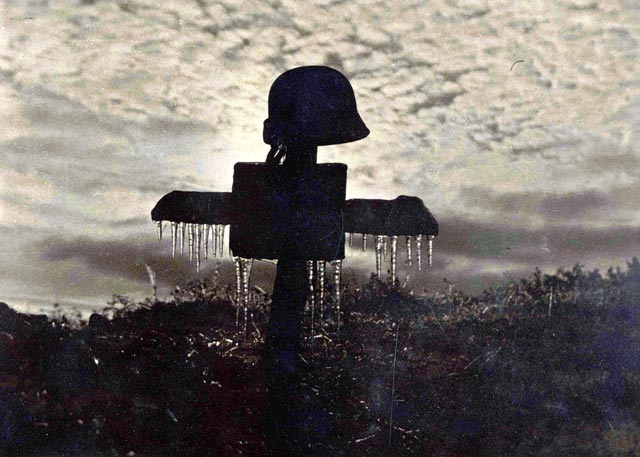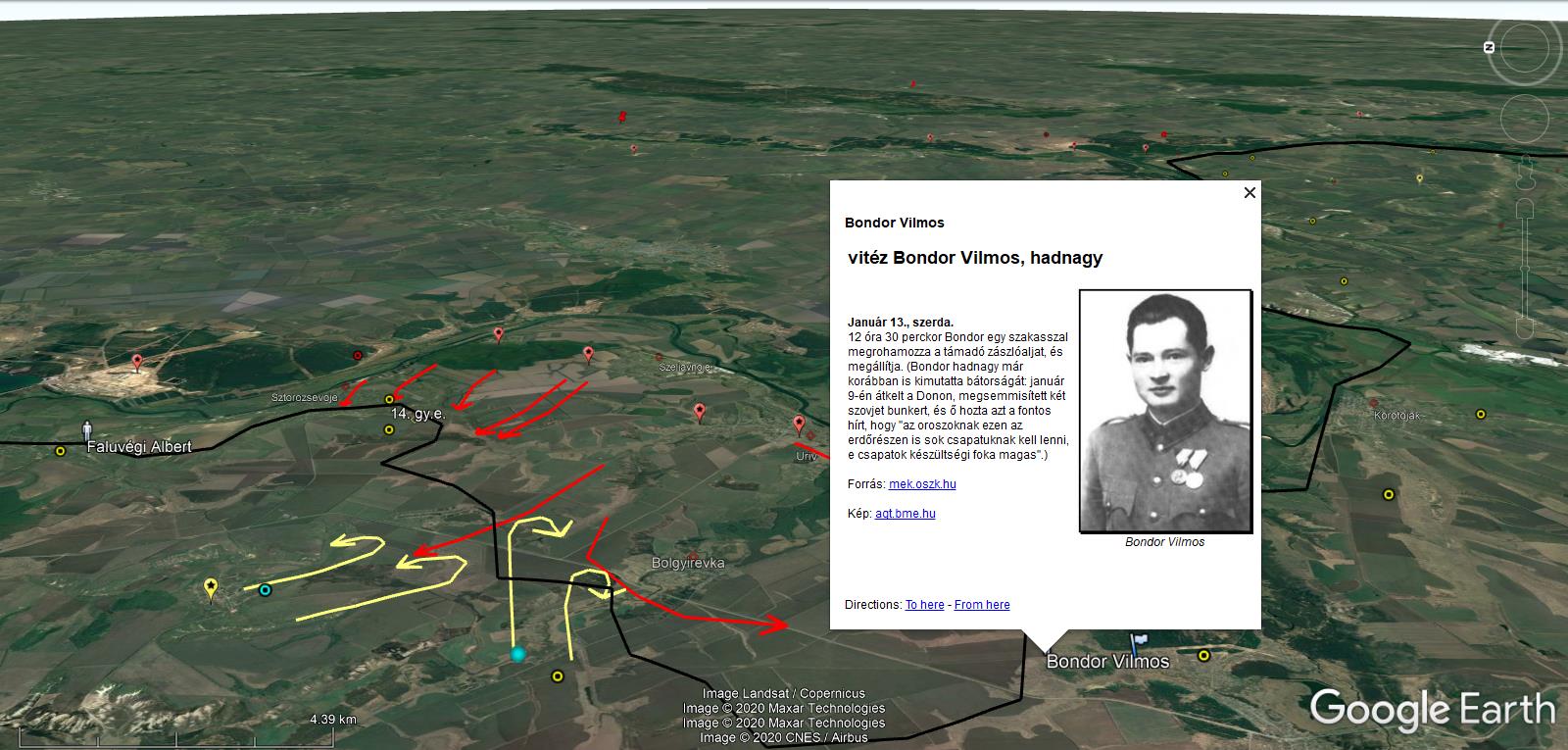Post by syzygy on Feb 21, 2019 13:03:22 GMT
Based on the book with the same title by Nemeskürty István and university thesis by Gebei László from 2015: Web visualisation of the Don break-through.
*****
*** Hungarian language version Google Earth presentation about the tragedy of the 2. Hungarian Army at Don-Bend, Voronezh front - WWII., 1943. I.-II. ***
*****
Note for foreign readers: English language glossary available on wikipedia. Please read before download!:
- The Don River, Operation Saturn, and disaster -

source
*****
*** Hungarian language version Google Earth presentation about the tragedy of the 2. Hungarian Army at Don-Bend, Voronezh front - WWII., 1943. I.-II. ***
*****
Note for foreign readers: English language glossary available on wikipedia. Please read before download!:
- The Don River, Operation Saturn, and disaster -

source
The Hungarian Second Army is probably the best known Hungarian wartime army because of the part it played in the Battle of Stalingrad. Before being sent to Russia, the rank-and-file of the Second Army had received but eight weeks of training. The only tactical experience for many of these soldiers were the maneuvers held just prior to the departure for the front. This lack of preparation badly affected the soldiers' fighting abilities and morale when confronted with heavy tank assaults. Also, a significant part of the army was made up by reservists (officers and enlisted men alike), who were promised a "quick victory" and became demoralized as their prospects for getting home soon were worsening.
In 1942, the Hungarian Second Army was given the task of protecting the 8th Italian Army's northern flank between Novaya Pokrovka on the Don River and Rossosh. This allowed the German Sixth Army to continue to attack Soviet General Vasily Chuikov's 62nd Army defending Stalingrad. As winter set in, and with the worsening German situation around Stalingrad, the 2nd Army's transportation collapsed and failed to supply even the basics (food, winter clothing, heating fuel, building materials) for the frontline units. The cold, hungry and demoralized 2nd Army had to defend even longer and longer stretches of the frontline as more and more German units were sent to Stalingrad.
The Hungarian Second Army, as almost all of the armies protecting the flanks of the Sixth Army, was annihilated when the Soviets launched Operation Uranus, Operation Saturn, and Operation Little Saturn.
...
On January 13, 1943, Russian forces, overwhelming in numbers and equipment, began the Voronezh-Kharkov Strategic Offensive Operation with the Bryansk, Voronezh, and Southwestern Fronts simultaneously. The Soviet Red Army was totally successful this time: during the Ostrogozhsk–Rossosh Offensive the Russians rapidly destroyed the Hungarian Second Army near Svoboda on the Don River. An attack on the German Second Army further north threatened to bring about an encirclement of that army as well, though it managed to withdraw and was forced to retreat. By February 5, 1943, troops of the Russian Voronezh Front were approaching Kharkov. The losses of the 2nd Army were made especially severe by the attitude of the Army command (Colonel General Vitéz Gusztáv Jány), who forbade any sort of withdrawal, in spite of seeing the neighbouring German and Italian Armies pulling back. Most of the Hungarian units were encircled and either annihilated or forced to open terrain where they succumbed to the extreme cold (-30C - -40C). The 1st Armored Division was reduced to a single operational tank within a few days, and most of the personnel of the 1st Air Group died on the ground when their airfields were overrun by Soviet tanks.
During its twelve months of activity on the Russian front, the Second Hungarian Army's losses were enormous. Of an initial force of about 200,000 Hungarian soldiers and 50,000 Jewish forced-laborers, about 100,000 were dead, 35,000 wounded, and 60,000 taken prisoners of war. Only about 40,000 men returned to Hungary, scapegoated by Hitler for the catastrophic Axis defeat. "No nation lost as much blood during World War II in such a short period of time.
In 1942, the Hungarian Second Army was given the task of protecting the 8th Italian Army's northern flank between Novaya Pokrovka on the Don River and Rossosh. This allowed the German Sixth Army to continue to attack Soviet General Vasily Chuikov's 62nd Army defending Stalingrad. As winter set in, and with the worsening German situation around Stalingrad, the 2nd Army's transportation collapsed and failed to supply even the basics (food, winter clothing, heating fuel, building materials) for the frontline units. The cold, hungry and demoralized 2nd Army had to defend even longer and longer stretches of the frontline as more and more German units were sent to Stalingrad.
The Hungarian Second Army, as almost all of the armies protecting the flanks of the Sixth Army, was annihilated when the Soviets launched Operation Uranus, Operation Saturn, and Operation Little Saturn.
...
On January 13, 1943, Russian forces, overwhelming in numbers and equipment, began the Voronezh-Kharkov Strategic Offensive Operation with the Bryansk, Voronezh, and Southwestern Fronts simultaneously. The Soviet Red Army was totally successful this time: during the Ostrogozhsk–Rossosh Offensive the Russians rapidly destroyed the Hungarian Second Army near Svoboda on the Don River. An attack on the German Second Army further north threatened to bring about an encirclement of that army as well, though it managed to withdraw and was forced to retreat. By February 5, 1943, troops of the Russian Voronezh Front were approaching Kharkov. The losses of the 2nd Army were made especially severe by the attitude of the Army command (Colonel General Vitéz Gusztáv Jány), who forbade any sort of withdrawal, in spite of seeing the neighbouring German and Italian Armies pulling back. Most of the Hungarian units were encircled and either annihilated or forced to open terrain where they succumbed to the extreme cold (-30C - -40C). The 1st Armored Division was reduced to a single operational tank within a few days, and most of the personnel of the 1st Air Group died on the ground when their airfields were overrun by Soviet tanks.
During its twelve months of activity on the Russian front, the Second Hungarian Army's losses were enormous. Of an initial force of about 200,000 Hungarian soldiers and 50,000 Jewish forced-laborers, about 100,000 were dead, 35,000 wounded, and 60,000 taken prisoners of war. Only about 40,000 men returned to Hungary, scapegoated by Hitler for the catastrophic Axis defeat. "No nation lost as much blood during World War II in such a short period of time.
Requiem egy hadseregrt.kmz (147.57 KB)(Turn all (except terrain) layers off and set elev. exaggeration 3 while browsing in GE / check folder structure, folder descriptions, from the 2nd day follow highlighted (name visible) placemarks for further read and sources / all credits given in kmz structure)
Attached kmz file only available here on the every-time "Live" GE Community Forums, which is now self-sponsored. If You make good use of this dataset, please donate our community! Thank You! |
Kmz file's folder structure divides into two main parts:
First part (The Don break-through) details the military operations (participants, units, movements, front-line changes) in the period of time under review.
Second part ("Don-Bend") contains
placemarks for existing sites of commemoration (graves and memorials), also
historical soldier-cemetery sites (locations need to be fixed) and
33 dead heroes (with place-, date- and cause of death, rank, age and profile photo displayed).
(In last folder I have selected interesting sites not related to the historical events directly, however I would visit if once I were there.)
------------------------------------------------------------------------------------------
Folder structure in english: (As some help for foreign readers.)
Requiem for an army
-The Don break-through
--Placemarks
---Relevant settlements
---Other
--Theater of War
---First day
----Front line
----Units movements
----Countries
----Units / sub-units (as: Army>Corps>Division>Regiment>Battalion)
----People - highlighted persons, their personal notes and/or been mentioned by their outstanding service
Example screenshot:

---Second day
---...
-"Don-Bend"
--Memorials, historical soldier-cemeteries
---Places (memorials, tombs), can be visited todays
---Historical cemetery sites
---Heroes portraits
--Other places of interest
-------------------------------------------------------------------------------------------
Roll down steps of disaster in 9 frames:
[slide captionposition="1" wrapperstyle="padding:10px 0;border-top:2px solid #eee;border-bottom:2px solid #eee;"]https://res.cloudinary.com/syzygy/image/upload/v1583961747/don-kanyar/slide/0111.jpg
1943. január 11.
res.cloudinary.com/syzygy/image/upload/v1583961744/don-kanyar/slide/0112.jpg
1943. január 12.
res.cloudinary.com/syzygy/image/upload/v1583961751/don-kanyar/slide/0113.jpg
1943. január 13.
res.cloudinary.com/syzygy/image/upload/v1583961749/don-kanyar/slide/0114.jpg
1943. január 14.
res.cloudinary.com/syzygy/image/upload/v1583961781/don-kanyar/slide/0115.jpg
1943. január 15.
res.cloudinary.com/syzygy/image/upload/v1583961773/don-kanyar/slide/0116.jpg
1943. január 16.
res.cloudinary.com/syzygy/image/upload/v1583961775/don-kanyar/slide/0118.jpg
1943. január 18.
res.cloudinary.com/syzygy/image/upload/v1583961778/don-kanyar/slide/0122.jpg
1943. január 22.
res.cloudinary.com/syzygy/image/upload/v1583961902/don-kanyar/slide/0127.jpg
1943. január 27.[/slide]
Main sources:
Nemeskürty István: Requiem egy hadseregért
mek.oszk.hu/08500/08575/08575.htm
Gebei László: webes megjelenítés A Don-kanyari áttörés webes megjelenítése c. szakdolgozathoz
mercator.elte.hu/~gebeilaszlo/web/nyitolap.html
Gebei László: A Don-kanyari áttörés webes megjelenítése c. szakdolgozat
lazarus.elte.hu/hun/digkonyv/szakdolg/2016-bsc/gebei_laszlo.pdf
Magyarország a XX. században - A 2. magyar hadsereg (1942–1943)
mek.oszk.hu/02100/02185/html/63.html
Wikipedia: 2. magyar hadsereg
hu.wikipedia.org/wiki/2._magyar_hadsereg
Szántó Mihály: A Magyar 2. hadsereg IV. hadtestének tevékenysége az 1943 januári Szovjet támadás után
epa.oszk.hu/00000/00018/00080/pdf/EPA00018_hadtortenelmi_1996_01_091-148.pdf
Other related sources:
magyaridok.hu # doniut.gportal.hu # origo.hu # arcanum.hu # ujkor.hu # zml.hu/PDF
All feedback welcome! Please point out wrong data and possible contradictions!
Thanks!
g
---
{Tags}Don kanyar Google Earth Don bend Google Earth voronyezs front ww2 wwii Don kanyar térkép Don bend map második világháború 2. Magyar hadsereg Hungarian 2. army történelem history
